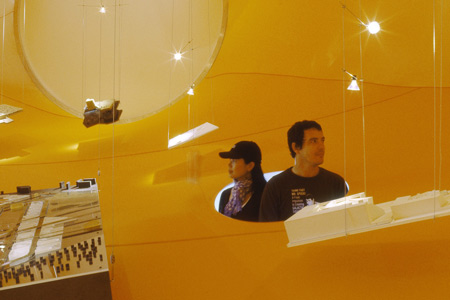
The functional system, which constitutes the Noh theater, the traditional theater of Japan is nomadological in the deepest sense in the way it harmonizes or structures its many elements to achieve a ‘performance’ made up of discrete units of music, dance, architecture, costume, and literature. It is structural insofar as it is the product of the relations of its parts. It is different from other forms of drama not by virtue of emphasis on one element or the next, for instance the ostensibly actor driven modern theater, or dance in a ballet or musical production, but in its dynamism. Most other forms of drama are more or less determined before they even begin, usually by an artistic and executive team and are thus more classically geometric. The structure of Noh however is determined internally, that is not from anybody directing the performance from outside, but from within the world of Nohgaku 能楽 itself, in the same way a piece of improvised jazz emerges from the collaboration of musicians.
Artistic decisions occur on the stage. The intricacy or inner tension that exists between these manifolds or elements of music/acting/time-space is what creates the dynamic and excitement of the individual performance (Komparu, 8)[i]. In the physical space of Noh, all the performers, including the musicians, occupy the same level of the stage. The Noh stage also partakes of the ritual and cultural space of the audience and surrounding environ, especially in the case of Takigi Noh 薪能, which is performed outdoors in torch light. In the case of Takigi Noh we may go as far to say that the cicadas vibrating and the leaves motion on a hot spring afternoon are also-or can be included in the greater melieu depending on our awareness and other affects. The experience of Noh opens up a space, a phenomenal continuity and places us within it. The space is not an “ambient (flat) Euclidian space or, in Weyl’s words, an (infinite) ‘residential flat’ (flat is a fitting pun here), where (phenomenally) geometric figures or (physically) material things are put.”[ii](Plotnitsky, 8) In early times, the Noh Butai was also the worship pavilion of the Buddhist and Shinto shrines, a loci for the intersection of all kinds of communal forces, where the inner and outer worlds broke down; or what Deleuze calls ‘any space whatever’.
Perhaps it is best put in the words of Kunio Komparu: “The noh stage, as a space of complete openness where a shared experience occurs, permits no separation of self and other, however momentary, by the intrusion of “enclosedness.”(Komaparu, 111) How similar this is to Deleuze’s idea of a “decentered and divergent” harmony (Komparu, 11) This divergent harmony is at the heart of Noh music as well and describes the subtle lines of flight of its discrete elements. While Komparu’s chapter the Music of Noh is well worth a read, I will try my best to attempt to summarize it here and try to point to its phenomenal implications. The music of noh also exists within the gaps or as Komparu calls it ma, which roughly translated means blank, time or opening (you can think of space as well). Like many Japanese words its meaning is ambivalent and relies on ambient context. Words and Kanji or Chinese script are believed to have a pulse, hence the art of Shodo, calligraphy and carry their own spirit or energy. The different musical parts of Noh are simple. It is primarily rhythmic music, with eight beats constituting a single unit, or what we in North America think of as measure. In our terms one quarter-note full beat actually corresponds to 1/8 note of sounds and 1/8 note of silence, respectively the down and upbeats or positive and negative time. Each measure begins on the upbeat, the silence which links the musical units together.
Not only does it connect the beats of the percussion, but ma allows for other divergent sounds to rush into the space of the piece, cascade into the void like a torrent flowing from the mountains creating exhilarating effects. The human soul is touched by the infinite and becomes a part of the composition. In a rather simple manner it opens up a space and creates a kind of composition that is more sophisticated than a simple piece of music. The Kake-goe かけ声 expresses this infinite and irrational or subconscious possibility. Kakegoe are vocables or meaningless words that are called out in between beats. In the spaces without Kakegoe one still anticipates. It has in that sense the characteristic of inflection described by Bernard Cache: “Preceding the vector, inflection makes of each of the points a possible extremum in relation to its inverse: virtual maxima and minima. In this way, inflection represents a totality of possibilities, as well as an openness, a receptiveness or anticipation.”[iii] And this is why it is significant to understand that what happens in Nohgaku is only half the performance. The other half if we can even summarize it is all that does not happen exerting a peculiar kind of virtuality.
Here are some videos for further interest...
http://www.youtube.com/watch?v=EUHD-DF_kfo&feature=related
http://www.youtube.com/watch?v=feUunMIUJUs&feature=related
[i] Komparu, Kunio. The Noh Theater: Principles and Perspectives. Warren, Conn.: Floating World, 2005. Print.
[ii] Plotnitsky, Arkady. "Manifolds: On the Concept of Space in Riemann and Deleuze." Virtual Mathematics (UK). Print.
[iii] Cache, Bernard, and Michael Speaks. Earth Moves: the Furnishing of Territories. Cambridge, Mass.: MIT, 1995. Print.
















